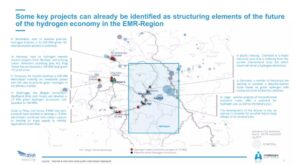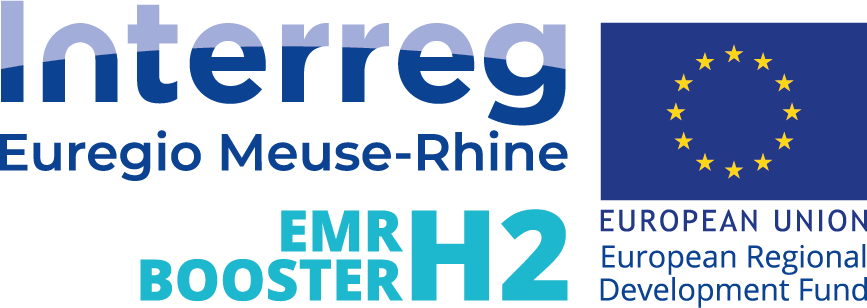Study report EMR H2-Booster roadmap available
Project partner, Cluster Tweed, ordered a study on the ‘Current state of the hydrogen economy in the Euregio Meuse-Rhine (EMR)’. The study was conducted by consultants of Seiya Consulting and Hydrogen Advisors, and was presented in a webinar in March this year. Now the final report of this roadmap is available.
The study emphasizes three key pillars for the development of a hydrogen economy: heavy-duty
transport, inland waterway transport, and interactions between SMEs. “The successful deployment of
hydrogen at scale is contingent upon the rapid deployment of pipelines, as it remains the most
scalable solution for hydrogen supply,” predict the consultants.
The EMR is very energy intensive and has a limited potential renewable. Surrounding regions (BeNeLux
and North-Rhine Westphalia) are in the same situation and the whole area will rely on hydrogen
imports, likely by pipeline from the North Sea (including the UK and Norway) and shipments of
hydrogen derivatives. The EMR can ride on the wave of this import dynamic, and quickly become a
scaled importer of hydrogen. The study emphasizes the critical role of pipelines infrastructure in
enabling the importation of hydrogen to the EMR. Importing hydrogen through pipelines offers a
scalable and efficient solution for meeting the region’s hydrogen demand.
On the offtake side, heavy duty road transport was identified as a key pillar for the hydrogen
economy. The region has a very dense road network and strong logistics activities, the ports of
Antwerp and Rotterdam being the biggest ports of Europe and delivering goods all across the region.
Hydrogen solutions still require financial support to be viable however, and support across the
3 countries of the EMR widely differ, leading to a very unbalanced deployment of hydrogen stations
and trucks. This heterogeneous deployment can slow down the whole region, including in Germany
where financial support is strong, as international transport constitutes a significant portion of the
traffic.
Inland waterway transport was identified as the second pillar. The Meuse/Rhine ecosystem is
the most active one in Europe, accounting for more traffic than the rest of Europe combined.
Hydrogen will be a key pillar for decarbonising the inland vessels. If all the inland vessels were to be
converted to hydrogen FCEV, we estimated the consumption would reach 150kt/y, equivalent to 1GW
of electrolyser power. The CCNR estimates that hydrogen should be responsible of 45% of the
propulsion (through liquid H2, compressed H2, or derivatives) by 2050. The EMR also has an
opportunity for building an ecosystem of competences to become a leader in H2 inland waterway
transport and later export these competencies.
Interactions between SMEs and other stakeholders (large groups, R&D hubs, competence
centres, …) play a vital role in unlocking the full potential of the EMR’s hydrogen ecosystem. By fostering
collaboration and mapping existing members along value chains, stakeholders can improve visibility,
foster innovation, and establish fruitful partnerships. Drawing inspiration from the successful
collaboration model observed in North Rhine-Westphalia, expanding this approach throughout the
EMR will strengthen the collective efforts and accelerate hydrogen-related developments.
“Now that a new and really engaged cross border hydrogen community has been built around the Francorchamps Hydrogen Initiative, we strongly advise to keep this ecosystem alive both via virtual and physical meetings,” concludes the study.
Download EMR H2 Booster roadmap study.
The presentations and recording of the webinar are also available.

